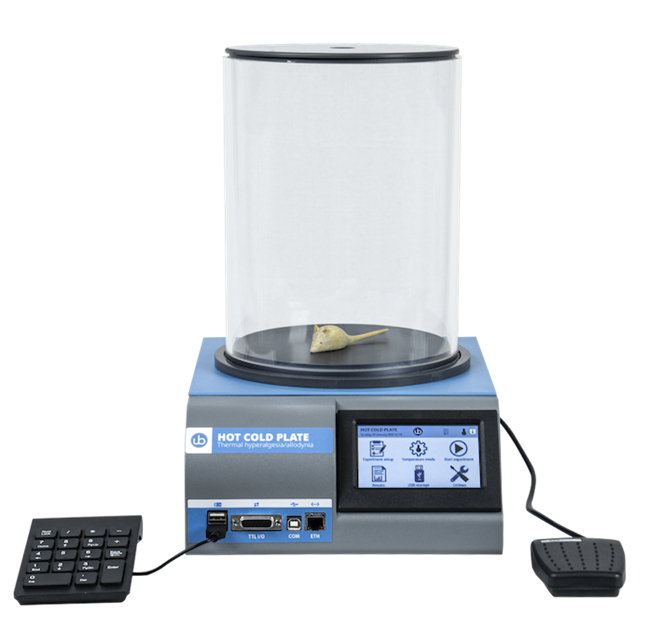产品展示NAVIGATION

电话:
传真:-8008
QQ:3007536035
地址:上海市闵行区兴梅路485号 XingMei Rd 485ShanghaiChina
冷热板测试仪
时间:2023-12-15来源:本站作者:金年会仪器

详细介绍
冷热板测试仪是评估动物冷、热痛觉异常性疼痛和痛觉过敏研究的经典工具,常用于慢性疼痛、神经病理性疼痛等镇痛药物研发、筛选和药效评估实验中。
在动物疼痛研究中,冷热板测试一直是啮齿动物冷、热痛试验的金标准。除了最常用的恒温方法外,研究者越来越偏爱能够以给定的时间速率将温度从起始点提高/降低到终点的设备,以区分伤害感受器亚型,从而检测痛觉过敏和异常性疼痛的差异。
Ugo basile冷热板测试仪具有温度变化范围广、多阶段测试可调等优点,可以灵活地进行从大小鼠痛觉过敏到异常性疼痛的多种疼痛实验。设备的静音运行模式可将实验动物的干扰降到最低,保证动物每次的伤害性反应都可在无拘束的自然条件下得出;并可通过U盘将实验数据导出为CSV文件,方便数据统计与处理。
在主机设置初始温度和目标温度后,将大鼠(小鼠)放置在冷热板上,冷热板会以稳定的速率进行降温或加热,当温度达到疼痛的敏感性节点时,引起动物伤害性反应(后爪舔舐、退缩或跳跃)

型号:35300
优势特点:
1. 三种温度控制模式,升降温速率自定义程度高
恒定温度模式:可控制温度在设定时间内持续稳定
线性升降温模式:可控制单位时间内温度变化速率恒定
急速升降温模式:可控制在最快时间达到目标温度
2. 大范围温度控制,冷、热刺激双模式
具有冷板和热板两种工作模式,-5℃至65℃大范围温度控制,切换控温模式方便快捷。可涵盖多种动物模型,应用广泛,在疼痛实验方案中获得的数据更全面。
3. 可通过软件编辑多个温控阶段
系统标配X-PAD软件,用户可自定义多段升降温模式,设置动物组别,并通过U盘将其上传到冷热板测试仪进行自动控制测试。
4. 具备数字键盘和脚踏板,记录动物反应和刻板行为
标配数字键盘和脚踏板,可以预设10个按键用以记录疼痛动物的异常反应和刻板行为(如舔、抓、跳、梳理、发声、直立、静止、攀爬、颤抖、抽搐)并将结果保存在测试主机中。

应用领域:
冷热板测试仪广泛用于研究伤害感受器、温度感知受体、冷热异常性疼痛和痛觉过敏的基础机制研究,以及炎症与神经理性疼痛疾病中镇痛药物(如阿片类药物)的精确、快速筛选测试,测试化合物抗伤害的药效,如坐骨神经慢性收缩损伤(CCI)模型。


型号规格:
| 35300 | 冷热板完整套装,包括主机、数字键盘、动物活动笼、U盘及软件等 |


参考文献:
1.Orthofer, Michael, et al. "Identification of ALK in Thinness." Cell 181.6 (2020): 1246-1262.doi: 10.1016/j.cell.2020.04.034
2.Trendafilova, Teodora, et al. "Sodium-calcium exchanger-3 regulates pain “wind-up”: From human psychophysics to spinal mechanisms." Neuron 110.16 (2022): 2571-2587.
3.Cao, Chenxi, et al. "Cholesterol-induced LRP3 downregulation promotes cartilage degeneration in osteoarthritis by targeting Syndecan-4." Nature Communications 13.1 (2022): 7139. doi: 10.1038/s41467-022-34830-4
4.Prieto, Martin, et al. "Light activated pulsatile drug delivery for prolonged peripheral nerve block." Biomaterials 283 (2022): 121453. doi: 10.1016/j.biomaterials.2022.121453
5.Hou, Yiwen, et al. "Coordinated activity of a central pathway drives associative opioid analgesic tolerance." Science Advances 9.6 (2023): eabo5627. doi:
6.Xing, Lei, et al. "Expression of human‐specific ARHGAP11B in mice leads to neocortex expansion and increased memory flexibility." The EMBO journal 40.13 (2021): e107093.
7.Cetin, Zeynep, et al. "The Role of Hydrogen Sulfide in the Development of Tolerance and Dependence to Morphine in Mice." Neuropsychobiology 80.3 (2021): 264-270. doi: 10.1159/000511541
8.Ford, Neil C., et al. "Role of primary sensory neurone cannabinoid type-1 receptors in pain and the analgesic effects of the peripherally acting agonist CB-13 in mice." British journal of anaesthesia 128.1 (2022): 159-173.doi:10.1016/j.bja.2021.10.020
9.Blomqvist, Kim J., et al. "Systemic hypertonic saline enhances glymphatic spinal cord delivery of lumbar intrathecal morphine." Journal of Controlled Release 344 (2022): 214-224. doi:10.1016/j.jconrel.2022.03.022
10.Gan, Zheng, et al. "Repetitive non-invasive prefrontal stimulation reverses neuropathic pain via neural remodelling in mice." Progress in neurobiology 201 (2021): 102009.
您想了解更多详细资料吗?
请与金年会联系:
TEL:,
QQ:3007536621
微信:yuyanbio
Mail:
欢迎您的咨询

